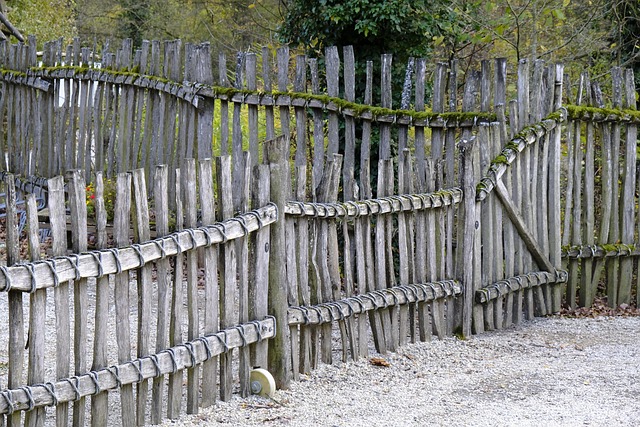Large properties present unique challenges when it comes to fencing, requiring solutions that balance privacy, security, and aesthetics with budget constraints. This article delves into cost-effective fencing options tailored for expansive landscapes, exploring materials like wood, vinyl, and metal that offer both affordability and durability. We’ll guide you through creative design strategies, installation best practices, and long-term maintenance tips to ensure your fencing project delivers value for years to come.
- Understanding Cost-Effective Fencing Needs for Large Properties
- Exploring Budget-Friendly Materials: Wood, Vinyl, and Metal
- Creative Design Options to Minimize Costs Without Compromise
- Installation Tips for Efficient and Affordable Fencing Projects
- Long-Term Savings: Maintenance and Durability Considerations
Understanding Cost-Effective Fencing Needs for Large Properties
Large properties present unique challenges when it comes to fencing, as the scale and diverse landscapes require tailored solutions. Understanding the specific needs of such properties is key to implementing cost-effective strategies. One primary consideration is the length and perimeter of the area to be fenced, which can vary significantly from one property to another. This initial assessment helps in determining the quantity and type of materials required, influencing overall costs.
Additionally, the purpose of fencing should be taken into account. Is it for security, privacy, aesthetics, or a combination of these? Different requirements may lead to different material choices and designs. For instance, secure fencing might involve robust materials like steel or concrete, while privacy fences could use solid wood or vinyl panels. By aligning fencing solutions with the property’s unique needs, it becomes possible to balance functionality, budget, and aesthetics effectively.
Exploring Budget-Friendly Materials: Wood, Vinyl, and Metal
When considering fencing for large properties, the choice of material plays a significant role in both aesthetics and budget. One of the most traditional and cost-effective options is wood. It offers a natural beauty and can be readily sourced, making it an affordable choice. However, wood requires regular maintenance to prevent rot and pest damage, which can increase long-term costs.
For a low-maintenance alternative, vinyl and metal fences are popular budget-friendly choices. Vinyl, often in the form of PVC, is durable, low-maintenance, and available in various styles to complement different property aesthetics. Metal fencing, typically made from steel or aluminium, offers strength and longevity with minimal upkeep. These materials are ideal for expansive properties as they can be easily installed and require less regular replacement compared to wood.
Creative Design Options to Minimize Costs Without Compromise
When fencing large properties, creative design options can significantly minimize costs while maintaining aesthetic appeal. One effective strategy is to incorporate natural elements like curved lines that mimic the landscape or using locally sourced materials such as wood or bamboo. These not only reduce material expenses but also blend harmoniously with the surroundings, creating a seamless outdoor space.
Additionally, modular fencing systems offer both cost-efficiency and design flexibility. Pre-fabricated panels can be assembled quickly and easily, reducing labor costs. Furthermore, these systems allow for customization, enabling you to create unique patterns or shapes that suit your property’s distinctive features. By combining creativity with practical considerations, you can achieve a stunning fence that aligns with your budget.
Installation Tips for Efficient and Affordable Fencing Projects
When installing fencing on large properties, efficiency and affordability go hand in hand. To achieve both, start by planning your layout meticulously. Use existing features like trees, slopes, or hedges as natural boundaries to reduce material needs and labour costs. Choose a fence type suitable for your terrain; for instance, post-and-rail fences are ideal for relatively flat ground, while more complex designs like split-rail or decorative fences might better suit varied landscapes.
Regularly spaced posts are key to structural integrity and long-term savings. Use high-quality, rot-resistant materials for posts, and opt for local suppliers to cut down on transportation costs. Pre-assembled components can also save time and money. Lastly, consider DIY methods for smaller sections or simpler designs; this can significantly reduce labour expenses. Remember, proper installation is crucial for both functionality and longevity, so take your time, follow instructions carefully, and don’t hesitate to consult professionals when needed.
Long-Term Savings: Maintenance and Durability Considerations
Investing in a durable fencing solution is essential for large property owners, as it offers long-term savings. Traditional fences may require frequent repairs and replacements due to weather conditions, vandalism, or poor installation. High-quality, maintenance-free fencing options, on the other hand, can withstand extreme temperatures, heavy winds, and even animal damage without compromising integrity. This longevity translates to fewer replacement costs and less time spent on upkeep.
Regular maintenance is often required with conventional fences, involving tasks such as painting, repairing, or replacing sections. These recurring expenses can add up over time. With modern, low-maintenance fencing materials, property owners can eliminate these costs. Durability features like corrosion-resistant metals, impact-resistant vinyl, or treated wood ensure the fence remains in pristine condition with minimal care, allowing homeowners to allocate their resources more efficiently and focus on other aspects of their property’s upkeep.
